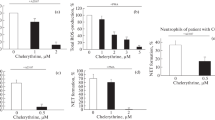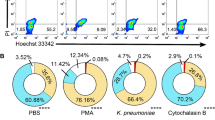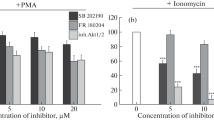Abstract
In the present study we investigated the TNF-α induced signal transduction mechanism in human neutrophil. Exogenously added TNF-α affects both PKC activity and its translocation from cytosol to the membrane. Endogenous protein phosphorylation pattern is inhibited in TNF-α induced neutrophil in Ca-dependent and Ca-independent manner, including a major 47 and 66 kDa cytosolic proteins, which may be implicated in superoxide anion generation. However TNF-α dose dependently enhances the expression of ζ-PKC isotype but not the β-PKC. Morphology and cell cytotoxicity are studied in TNF-α treated neutrophil to understand the TNF-α induced cell death or apoptosis and these experiment is further confirmed by DNA fragmentation analysis. These results clearly demonstrate that TNF-α induces cellular death of human neutrophil at least in part by enhanced expression of Ca-independent ζ-PKC. These observations provide an insight towards understanding the function of ζ-PKC in apoptotic pathway.
Similar content being viewed by others
References
Carswell EA, Old LJ, Kassel RL, Green S, Fiore N, Williamson B: An endotoxin-induced serum factor that causes necrosis of tumor. Proc Natl Acad Sci 72: 3666–3680, 1975
Beutler B, Cerami A: The biology of Cachectin/TNF-α a primary mediator of the host response. Annu Rev Immunol 7: 625–655, 1989
Cerami A: Inflammatory cytokines. Clin Immunol Immunopathol 62(1): S3–S10, 1992
Klebanoff SJ, Vadas MA, Harlan JM, Sparks LH, Gamble JR, Agosti JM, Waltersdorph AM: Stimulation of neutrophils by tumor necrosis factor. J Immunol 136(11): 4220–4225, 1986
Ohta H, Yatomi Y, Sweeney AE, Hakomori S, Igarashi Y: A possible role of sphingosine in induction of apoptosis by tumor necrosis factor-α in human neutrophil. FEBS Lett 355: 267–270, 1994
Parker PJ, Coussens L, Totty N, Rhee L, Young S, Chen E, Stabel S, Waterfield MD, Ullrich A: The complete primary structure of protein kinase C-The major phorbol ester receptor. Science 233: 853–859, 1986
Coussens L, Parker PJ, Rhee L, Yang-Feng TL, Chen E, Waterfield MD, Francek U, Ullrich A: Substrate recognition by Ceramide-activated protein kinase-Evidence that kinase activity is prolinedirected. Science 233: 859–866, 1986
Kikkawa U, Kishimoto A, Nishizuka Y: The protein kinase C family: Heterogeneity and its implication. Ann Rev Biochem 58: 31–44, 1989
Majumdar S, Rossi WM, Fujiki T, Phillips AW, Disa S, Queen FC, Johston BR, Rosen MO, Corkey EB, Korchak MH: Protein kinase C isotypes and signaling in neutrophils. J Biol Chem 266: 9285–9294, 1991
Majumdar S, Kane HL, Rossi WM, Volpp DB, Nauseef MW, Korchak MH: Protein kinase C isotypes and signal-transduction in human neutrophils: Selective substrate specificity of calcium-dependent β-PKC and novel calcium-independent nPKC. Biochimica et Biophisica Acta 1176: 276–286, 1993
Shutze S, Nottrott S, Pfizenmaier K, Kronke M: Tumor necrosis factor signal transduction: Cell type specific activation and translocation of protein kinase C. J Immunol 144: 2604–2608, 1990
Mathias S, Dressler KA, Kolesnick RN: Characterisation of a ceramide-activated protein kinase: Stimulation by tumor necrosis factor α. Proc Natl Acad Sci 88: 10009–10013, 1991
Joseph CK, Byun HS, Bittman R, Kolesnick RN: Substrate recognition by Ceramide-activated protein kinase-Evidence that kinase activity is proline directed. J Biol Chem 268: 20002–20006, 1993
Raines MA, Kolesnick RN, Golde DW: Sphingomyelinase and ceramide activate mitogen-activated protein kinase in Myeloid HL-60 cells. J Biol Chem 268: 14572–14575, 1993
Pfizemnaier K, Himmler A, Schutze S, Scheurich P, Kronke M: In B. Beutler (ed.), Tumor necrosis Factor: The molecules and their Emerging Role in Medicine. Raven Press, New York, NY. 1992 pp 439–472
Bell RM, Burns DJ: Lipid activation of protein kinase C. J Biol Chem 266: 4661–4664, 1991
Muller G, Ayoub M, Storz P, Rennecke J, Fabbro D, Pfizenmaier K: PKC is a molecular switch in signal transduction of TNF-α, bifunctionally regulated by ceramide and arachidonic acid. EMBO J 14(9): 1961–1969, 1995
Hannun AY, Obeid ML: Ceramide: An intracellular signal for apoptosis. TIBS 20: 73–77, 1995
Westwick JK, Bielawska AE, Dbaibo G, Hannun YA, Brenner DA: Ceramide activates the stress-activated protein kinases. J Biol Chem 270: 22689–22692, 1995
Whyte MKB, Meagher LC, MacDermot J, Haslett C: Impairement of function in aging neutrophils is associated with apoptosis. J Immunol 150: 5124–5134, 1993
Hebert MJ, Takano T, Holthofer H, Brady HR: Sequential morphologic events during apoptosis of human neutrophils-Modulation by lipoxygenase-derived eicosanoids. J Immunol 157: 3105–3115, 1996
Waage A, Halstensen A, Espevic T: Association between tumor necrosis factor in serum and fatal outcome in patients with meningo coccal disease. Lancet 1: 355, 1987
Boyum A: Isolation of mononuclear cells and granulocytes from human blood. J Clin Lab Invest 21 (Suppl 97): 77–89, 1968
Korchak HM, Vienne K, Rutherford LE, Wilkenfeld C, Finkelstein MC, Weissmann G: Stimulas response coupling in human neutrophil. III. Differential requirements for receptor occupancy in neutrophil responses to a chemoattractant. J Biol Chem 259: 4076–4082, 1984
Lowry OH, Rosebrough NJ, Farr AL, Randall RJ: Protein measurement with the Folin-phenol reagent. J Biol Chem 193: 265–275, 1951
Williamson DH, Fennell DJ: The use of fluorescent DNA binding agents for detecting yeast mitichondrial DNA. Methods Cell Biol 17: 335–351, 1975
Susin SA, Zamzami N, Larochette N, Dallaporta B, Marzo I, Brenner C, Hirsch T, Petit PX, Geuskens M, Kroemer G: A cytofluorometric assay of nucler apoptosis induced in a cell free system: Application to ceramide induced apoptosis. Exp Cell Res 236: 397–403, 1997
Jaattela M: Biology of disease: Biologic activities and mechanisms of action of tumor necrosis factor a / Cachectin. Lab Inv 64: 724–742, 1991
Jonathan DK, Susan S, David JB, McPhail Linda C: Identification and regulation of protein kinase C-δ in human neutrophil. J Immumol 157(10): 4641–4647, 1996
McPhail LC, Harvath L: Signal transduction in neutrophil oxidative metabolism and chemotaxis. Natural Immune System: The Neutrophil. Oxford University Press, Oxford. 1993, pp 63–107
Kobayashi Y, Utsunomiya N, Nakanishi M, Osawa T: Early transmembrane event in tumor necrosis factor and lymphotoxin induced cytotoxicity. Immunol Lett 15: 53–57, 1987
Pontremoli S, Melloni E, Sparatore B, Michetti M, Salamino F, Horecker BL: Isozymes of protein kinase C in human neutrophils and their modification by two endogenenous proteinases. J Biol Chem 265: 706–712, 1990
Clark RA, Volpp BD, Leidal KG, Nauseef WM: Two cytosolic components of the human neutrophil respiratory burst oxidase translocate to the plasma membrane during cell activation. J Clin Invest 85: 714–721, 1990
Kramer IM, Verhoeven AJ, van der Bend RL, Weening RS, Ross D: Purified protein kinase C phosphorylates a 47 kDa protein in control neutrophil cytoplasts but not in neutrophil cytoplasts from patients with the autosomal form of Chronic Granulomatous disease. J Biol Chem 263: 2352–2357, 1988
Heyworth PG, Karnovsky ML, Badway JA: Protein phosphorylation is associated with synergistic stimulation of neutrophil. J Biol Chem 264: 14935–14939, 1989
Segal AW, Heyworth PG, Cockcroft S, Barrowman MM: Stimulated neutrophils from patients with autosomal recessive Chronic Granulomatous disease fail to phosphorylate a Mr-44,000 protein. Nature 316: 547–549, 1985
Lomax KJ, Leto TL, Nunoi H, Gallin JI, Malech HL: Recombinant47–Kilodalton cytosolic factor restores NADPH oxidase in Chronic Granulomatous disease. Science 245: 409–412, 1989
Clark RA, Malech HL, Gallin JI, Nunoi H, Voill BD, Pearrson DW, Nauseef WM, Curnutte JT: Genetic varients of Chronic Granulomatous disease: Prevalence of deficiencies of two cytosolic components of the NADPH oxidase system. N Engl J Med 321: 647–652, 1989
Musker R, Gasson J, Ogawa M, Koeffier HP: Recombinant human TNF induces production of granulocyte-monocyte colony stimulation factor. Nature 323: 79–82, 1986
Okamura N, Curnutte JT, Roberts RL, Babior BM: Relationship of protein phosphorylation to the activation of the respiratory burst in human neutrophil. J Biol Chem 263: 6777–6782, 1988
Okamura N, Malawista SE, Roberts RL, Rosen H, Ochs HD, Babior BM, Curnutte JT: Phosphorylation of the oxidase related 48 K phosphoprotein family in the unusual autosomal cytochromenegative and x-linked cytochrome-positive types of Chronic Granulomatous Disease. Blood 72: 811–816, 1988
Nakanishi H, Brewer KA, Exton JH: Activation of the ζ-isozyme of protein kinase C by phosphatidylinositol 3,4,5–triphosphate. J Biol Chem 268: 13–16, 1993
Kuby J: Immunology. Copyright by W.H. Freeman and company, Printed in USA, 289–299, 1992
Hanun YA: Function of ceramide in coordinating cellular responses to stress. Science 274: 1855–1859, 1996
Cirard D, Paquin R, Beaulieu AD: Responsiveness of human neutrophil to interleukin-4: induction of cytoskeletal rearrangements, de novo protein synthesis and delay of apoptosis. Biochem J 325: 147–153, 1997
Oberhammer F, Wilson JW, Dive C, Morris ID, Hickman JA, Wakeling AE: Apoptotic death in epithelial cells: Cleavage of DNA to 300 and/ or 50 kb fragments prior to or in the absence of internucleosomal fragmentation. EMBO J 12: 3679–3684, 1993
Sveinbjornsson B, Rushfeldt C, Olsen R, Smedsord B, Seljelid R: Cytotoxic effect of cytokines on murine colon carcinoma cells involves TNF-α mediated apoptosis. Biochem Biophys Res Comm 233: 270–275, 1997
Author information
Authors and Affiliations
Rights and permissions
About this article
Cite this article
Das, S., Bhattacharyya, S., Ghosh, S. et al. TNF-α induced altered signaling mechanism in human neutrophil. Mol Cell Biochem 197, 97–108 (1999). https://doi.org/10.1023/A:1006935114624
Issue Date:
DOI: https://doi.org/10.1023/A:1006935114624




